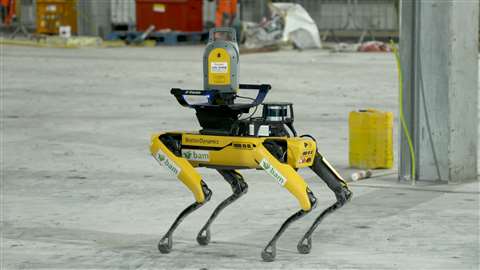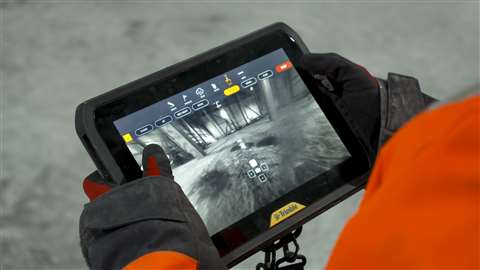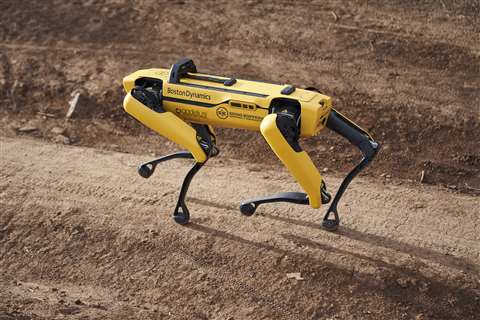How is Spot the robot being used on construction sites?
28 July 2022
Trialled as part of the UK government’s 5G programme, BAM Nuttall is one of the first contractors around the world to start using a Boston Dynamics robot for site surveys and monitoring progress. Lucy Barnard asks head of innovation, Colin Evison, how ‘Spot’ is making a difference to construction
Construction workers in the remote Shetland Islands, a windswept and rugged archipelago off the coast of mainland Scotland are not known for being easily disconcerted.
But when UK-headquartered contractor BAM Nuttall started using a four-legged construction robot at a high voltage direct current (HVDC) substation project in Kergord, an area of woodland three miles from the coast, it turned heads.
“It’s difficult for the novelty factor to wear off,” says Colin Evison, head of innovation at BAM Nuttall as he watches Spot amble past.
“At the moment it’s like, ‘oh look there’s a robot on the site’ and everyone just sort of stands there and watches which doesn’t do much for productivity. But that’s just because it’s something new and something novel. The more you get it out there during the day, the more people will just stop paying it attention.”
 BAM Nuttall’s ‘Spot’ robot in Shetland. Photo: Bam Nuttall
BAM Nuttall’s ‘Spot’ robot in Shetland. Photo: Bam Nuttall
Sized somewhere between a Dalmatian and an Alsatian, his distinctive yellow and black frame standing out against the surroundings, Spot does at first appear unnervingly cute.
Spot the robot dog
The robot has four dog-like legs which bend backwards, a bit like a bird’s, and instead of a head, it has a series of sensors and other gadgets placed on a metal basket. The legs enable the robot to climb up and down stairs as well as to walk through puddles and, AI enables it to negotiate its way around obstacles.
“It can also look quite menacing to be honest,” Evison adds, “When you’re in the same room and it’s coming towards you the cuteness quickly wears off.”
In January 2022, Bam Nuttall became one of just a handful of contractors currently using a ‘Spot’ robot on its construction site.
First launched by US-based robotics firm Boston Dynamics in 2016, Spot robots have been leased out to businesses since 2019 and available to purchase since 2020. The robots have been used for a wide variety of purposes including working with Massachusetts State Police to clear suspicious packages, identifying structural and safety issues at the Roman ruins of Pompeii, patrolling the SpaceX Starbase rocket testing facilities, and encouraging social distancing in Singapore.
Construction is one of the key industries Boston Dynamics is focusing on when marketing the robots to business customers, along with manufacturing, power and utilities and research.
In 2019 the company signed agreements with a string of tech firms specialising in construction software in order to make Spot more construction friendly. These include an agreement with HoloBuilder to create an app called SpotWalk aimed at helping Spot take frequent 360-degree photos on a construction site, partnerships with Trimble and FARO to integrate laser scanning via Point Cloud technology into Spot enabling the robot to create accurate 3D models of sites which can then be super-imposed onto a BIM model to spot any inconsistencies or conflicts.
Site monitoring in construction
“Most construction projects suffer from schedule overruns and therefore cost overruns,” says Brian Ringley, product manager for construction at Boston Dynamics, the man charged with promoting Spot to the construction sector.
“We think a lot of that problem centres around the ability to effectively monitor and manage the jobsite. And that level of comprehensive site visibility really requires an unprecedented amount of reality capture and site data – and that’s where Spot comes in. If you capture data more frequently, that means less change from capture to capture, which means that your downstream analysis applications will actually work more effectively,” he adds.
This, says Ringley, means that with Spot providing frequent site updates integrated into a BIM model, users can easily check whether each element has been installed correctly and at the right time. He says the software can be used as a metric by contractors and clients to agree completion dates and release payments.
For Bam Nuttall, which is using Spot to monitor the construction of a 55,176m2 substation linking Shetland’s wind farms to the national grid, Spot has been fitted with a Trimble X7 laser scanner in order to take frequent accurate measurements.
“In this case, we’re working on a converter station so, there are lots of different buildings which then house transformers and switch gear and so on. What’s critical for us is the flatness of the floor slab,” says Evison. “Spot can do that survey and measure the flatness of the floor. When you download the data, you can overlay it against your theoretical model and it shows red or green areas, slightly higher or slightly lower compared to where it should be.”
 A Bam Nuttall operative uses a tablet to operate Spot. Photo: BAM Nuttall
A Bam Nuttall operative uses a tablet to operate Spot. Photo: BAM Nuttall
Evison adds that the contractor also uses a tool which allows it to take a 360-degree photo at the same point every day.
“We use Spot for the kinds of low value tasks where you shouldn’t really be using a person to do it and where it is really important to get good information,” he says.
“For a person, it’s a bit hit and miss as to where you hold the camera and whether it is exactly the same time each day. “And actually, is it a good use of a qualified engineering graduate to just hold a camera in the air and take a picture?”
Moreover, Evison adds, one of the key reasons for using Spot is the machine’s 5G connectivity capabilities. In January, the UK government announced that BAM Nuttall was one of nine projects across various different industries across the UK to be part of a state-funded trial to explore the potential of 5G.
This upgraded mobile network is expected to revolutionise internet connectivity around the world, increasing connection speeds and improving the performance of existing gadgets. It will also lay the foundations for private 5G networks which limit connectivity to devices in a dedicated space such as factories, hospitals, schools and even construction sites. The networks are expected to underpin the use of driverless cars and increase automation via IoT devices.
“We started with the 5G project and then we started to explore different tools that we could use on the 5G network,” Evison says. “We would probably have got to where we are using Spot but the 5G project has enabled us to get there a bit quicker and I think what it’s doing now is already stimulating interest in what are the other things you can do with it.”
In March BAM Nuttall and its partners UK-based tech company AttoCore and UK-based research company Building Research Establishment switched on and used 5G on the Kergord site, making it the first construction site in the UK to host a private stand-alone 5G network.
The technology has enabled BAM Nuttall to set the device up so that it can be used remotely through the internet with a colleague as far afield as Finland logging into the device to carry out surveying tasks. For a hard-to-reach site like Kergord, located in challenging terrain, where weather conditions are often cold, wet and harsh and winter daylight hours are short, Evison says the benefits of using the technology are obvious.
How is robotics being used in construction?
“Instead of you taking a day to travel to site and do an inspection, you can log into Spot and effectively do a walk round the site,” says Evison. “It’s a real game-changer. Suddenly a person anywhere in the world, can do that site survey, as long as they’ve got an internet connection. If it’s difficult or expensive or logistically challenging to get to the site, you could be sat at home and you could be capturing that data on one site in the morning, do another one in the afternoon. It’s quite a significant shift for the industry.”
Although BAM Nuttall was only leasing its first Spot from Boston Dynamics, the company says it has been so impressed with the robot that it has decided to buy one.
“It’s one of these things that sounds expensive at first,” says Evison. “But when you think about it humans aren’t cheap, they need holiday pay and feeding and transportation so it’s tricky to do that kind of comparison. Also robots don’t complain if they have to go out in the rain.”
And, Evison says, since the company has started using the robot, it is discovering more and more uses for it.
“The way we’re using it, we’re pushing the boundaries and seeing what it can do,” he says. “Although it is being used on one isolated construction site, lots of other people in the company are going, ‘can it do this, can it do that?’ So it’s almost an introduction to what construction robotics might be. It’s not an end in itself but it’s a good way of raising awareness and people can see first-hand rather than just read about it or see it on youtube, they can actually put it to the test on site.”
The company is considering future uses for Spot which could include surveying work on the company’s many railway projects, security or even construction work.
“It’s funny that people call it a dog but what it is essentially is a platform for carrying different payloads,” says Evison. “In this case we’ve got a scanner on the top, but you could take that off and put an air quality monitor or a thermal image carrier instead. It’s a platform to carry different payloads and perform, either remote controlled or automated tasks.”
 Spot in action. Photo: Boston Dynamics
Spot in action. Photo: Boston Dynamics
Evison adds that, “The next stage is automating the construction itself. It’s only a question of time. I guess once you start to see what’s possible, you start to say, can you lift stuff and carry it around? And the answer is yes.
“You just need to put an arm on it, or you need a bigger robot that’s designed to do that. So, I guess, although it’s being used for a surveying task, it’s also opening up people’s minds to what robotics can do and what advantages there might be.”
Yet, despite the obvious advantages to construction site managers, Evison says that it will take some time before construction robotics enters the mainstream.
Currently Spot only has a 90-minute battery life before it has to return to its docking station to recharge.
“This is something that will only improve with time,” Evison says.” It’s just a question of how much load on the battery there is and how good the battery is at storying the power so that mission time will improve. To be honest, if it’s doing it on its own or at night or just getting on with the job, it doesn’t really matter if it’s doing it in chunks. It just consistently does the work.”
Similarly, Evison says that the robot is currently unable to open and close gates, making it difficult for it to access some parts of the site.
“We’ve got dedicated walkways on the site and they’ve got a spring-loaded gate and the way that we’ve got it set up Spot can’t negotiate that,” he says. “So, either you have to take it round a different route or you have to have someone that opens the gate because it doesn’t know what a gate is, it just sees it as a physical barrier and it won’t go through it. You could have an arm on the top of it to manipulate doors and so on but we haven’t got that arm installed on our unit.”
One major concern for potential owners, must also be the robot’s vulnerability to being hacked – something which in this particular case could compromise a major piece of infrastructure. Evison admits that, as an IoT-enabled device, Spot could be vulnerable to remote attacks, but says that there are ways to limit the machine’s exposure.
“There are a couple of levels of authentication needed to log in to Spot. You need to log in to your Trimble account and then you need to log in to the particular robot as well. Still, if you put in enough time and enough effort you probably could hack into his controls,” he says. “But Spot is not out on site ready to deploy all the time. We keep it in a locked room and you need someone there locally to authorise that it can now be used. It’s a bit like, someone could steal your car key, but if the garage is locked, they can’t steal your car.”
How much does Spot the robot cost?
Spot’s high cost is another factor which is likely to put many potential buyers off. The robots currently retail at US$74,500 for the basic unit which, by the time you have added on extras and a full support package, Evison says puts the cost at “under $100,000”. However, over time, this is likely to reduce and a number of Chinese firms are already manufacturing rival quadruped robots which they are selling for less than a tenth of the price.
But, despite the current drawbacks, Evison believes that over the next couple of decades, robots on construction sites will become commonplace.
“When we had the first hydraulic excavator on site it was like, oh, I don’t have to use a shovel any more that’s different,” he says. “Now it’s just something you see every day – construction sites have excavators. It is just something you need to get over.”
STAY CONNECTED



Receive the information you need when you need it through our world-leading magazines, newsletters and daily briefings.
CONNECT WITH THE TEAM








